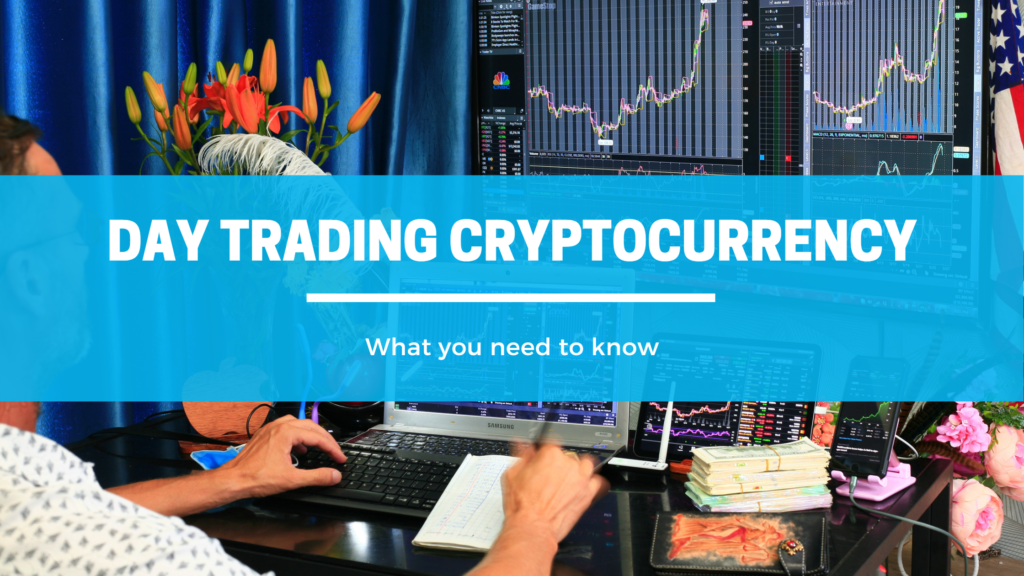Day trading is a great chance for traders who have a good understanding of the market and how it behaves to make daily profits. One of the fastest-growing asset types in terms of popularity is cryptocurrencies. This market comes with great opportunities for day traders. Crypto is known for price movements and discrepancies that do not exist in other markets. The volatile world of crypto requires nerves of steel and a successful strategy and also comes with a lot of risks.
Here, we will give a general insight into day trading cryptocurrency, what it means, what controls it, what to avoid, how to be a successful day trader, and the best strategies to gain an edge over the market.
Cryptocurrency
In recent years, traders have viewed cryptocurrency as a new market with big profit opportunities. Cryptocurrencies are digital assets protected by algorithms like proof-of-work or proof-of-stake, and data is stored on a digital ledger. Now, numerous cryptocurrencies exist, offering day traders many trading options.
Bitcoin is now considered a standard coin in the world of crypto. Not only has its popularity risen, but it has also evolved in terms of technology. It’s a decentralized currency. Bitcoin has a limited supply of 21 million coins.

Bitcoin is one of the most popular options for people wishing to day trade cryptocurrency due to its high liquidity. With a market valuation of around $200 billion, Bitcoin is undoubtedly the most valuable cryptocurrency on the stage. It accounts for more than half of trading activity in the world, with a daily turnover of billions.
An altcoin, on the other hand, is a kind of cryptocurrency that isn’t bitcoin. Any cryptocurrency that falls under this category has many technological variations and applications, like dApps and creating a decentralized finance world. Ethereum, a decentralized, open-source blockchain, is considered as one of the most common altcoins. Many additional altcoins come in the ERC-20 tokens form that are based on the Ethereum system. TRON and EOS are two examples of these altcoins.
A kind of cryptocurrency that has impressively grown in popularity is Stablecoins. Stablecoins are cryptocurrencies with reasonably consistent prices since they’re pegged to fiat currency. USDT is considered to be the most well-known stablecoin, with a price pegged to the United States dollar.
Tether, or USDT is a wonderful trading pair for both alt coin and bitcoin traders since it makes them able to trade in cryptocurrencies without being forced to offload cash to fiat currency first and then back into the market.
The Difference Between Fiat and Stablecoins
Transacting in US dollar, Euro, or other fiat currencies has significant regulatory costs. Exchanges with big US-based and Europe-based customer bases, like Kraken, Coinbase, and Bitstamp, tolerate this regulatory cost and invest in AML/KYC programs. As a result, exchanges that feature fiat pairs are more careful about the cryptocurrencies offered to their customers.
There are quite a lot of crypto exchanges that only trade in stablecoins or other cryptocurrencies, particularly those in Asia and outside the United States, like Binance, OKEx, and Huobi. Customers can typically find a considerably greater selection of crypto priced against stablecoins due to the fewer regulatory limitations. By transacting solely in cryptocurrencies, you get to bypass the traditional financial system. We have a full guide on cryptocurrency trading platforms in Singapore.
Spot and Derivatives
The word “Derivatives” refers to financial instruments whose values are dependent on and derived from spot prices, whereas spot trading deals with the exchange of physical assets.
The most widely traded derivatives are futures; they reflect a standardized agreement to exchange assets at a certain future date. With the growth of the crypto industry, exchanges have started to offer previously unavailable futures trading opportunities. Customers can trade bitcoin futures instead of spot trading on exchanges such as Bakkt and CME.
Other derivatives, such as perpetual swaps and options, have recently grown in popularity. However, they come with a higher level of complexity that a trader must grasp before engaging in any trade.
Market Access
Crypto exchanges cater to customers worldwide, and they are largely unregulated. They are thus open 24 hours a day, seven days a week. Cryptocurrency day traders can place an order at any time of day, and exchanges are open 24 hours a day, 7 days a week to ensure that their customers have convenient market access. Because the crypto markets are open 24 hours a day, traders can buy and sell without any restrictions.
The convenience of being able to trade whenever you choose is one of the benefits of having access to the market 24 hours a day, 7 days a week, instead of suiting the market.
In practise, however, exchanges might be down for system upgrades and maintenance on a regular basis.
Also, the market is a double-edged sword since it is open 24 hours a day, seven days a week. Because cryptocurrency is always open, there are fewer patterns in the day when traders may make predictable and profitable trades. Cryptocurrency day traders may find themselves looking at charts for longer periods than they would in traditional markets, waiting for the best time to execute a trade. This makes it more difficult to see patterns.
Blockchain
You don’t have to grasp the complex world of blockchain to start day trading, but a basic understanding of it will do the trick. It's a list of secure documents that are always growing. Cryptography works on securing the interactions and stores them publicly. They act as a public ledger, eliminating the need for intermediaries like banks. Understanding the blockchain can help you react to future news and announcements that could help you predict future price fluctuations.
Exchanges
With exchanges operating in many legal jurisdictions worldwide, the cryptocurrency market is very fragmented. Traditionally, traders had to go to a broker who was a member of the exchange to get access to the exchange. Now, It’s fairly simple to set up an exchange in many parts of the world, which has resulted in a proliferation of trading platforms.
liquidity providers, or market makers, are attracted to each exchange in order to give bids and offers to the exchange order book. These bids and offers influence price and liquidity.
Because exchanges can differ dramatically in terms of liquidity or pricing, crypto day traders find a lot of opportunities, as well as risks.
Funding
There are a good number of options for crypto day traders to fund their accounts. Most exchanges accept bank accounts and wire transfers, as well as any debit card payment. PayPal and credit cards are less typical payment options, but some exchanges allow them. Some of these alternate funding choices may come with hefty fees, so it’s better to check the fine print carefully.
If you’re an active day trader, you can always fund the Tether, or USDT is a wonderful trading pair for both altcoin and bitcoin traders since it allows them to trade in cryptocurrencies without being forced to offload cash to fiat currency and back into the market. account from the crypto wallet.
Security
Several exchange accounts have been compromised, and some traders would lose their cryptocurrency to a lack of security. Fortunately, in recent years, most exchanges' security has significantly improved and hacks occurrence have become rare. However, one of the most important factors to consider while day trading cryptocurrencies is security.
You should only choose exchanges that can guarantee the safety of all funds. Most of the popular exchanges, particularly those that operate in well-regulated jurisdictions, have a long track record of success, because at the end of the day, an exchange is as good as the security it offers!
Regulation
The security and safety of cryptocurrency trading are heavily reliant on regulation. As mentioned above, crypto day traders can be prone to hacks. Exchange regulation aids in lowering such risks and ensuring the safety of traders’ funds.
In the United States, cryptocurrency regulation isn't well established, but market participants and regulators are actively trying to make things better. Due to the failure of the federal government to create effective rules, most states have introduced statewide legislation in order to regulate each and every company in the industry.
All US-based cryptocurrency exchanges must follow certain regulations, such as Anti-Money Laundering (AML) and Know Your Customer (KYC) regulations, which require exchanges to verify their customers' identities and ensure that anyone involved in illegal activity cannot participate in the market.
Outside of the US, digital assets are regulated to varied degrees depending on the country. ICOs, exchanges, and others are regulated in crypto-friendly countries such as Switzerland. Several countries, such as Bolivia, Vietnam, and Morocco, have outlawed the use of all cryptocurrencies, regardless of the purpose.
Tax
There has been a lot of debate about how cryptocurrencies are viewed by the IRS. The IRS determined in 2014 that bitcoin, as well as other cryptocurrencies are “intangible property” rather than currency. One key result of this decision is that the IRS's wash-sale tax regulations don’t apply. This gives the chance for crypto day traders to claim losses on trades right away, even if they repurchase the same cryptocurrency within 30 days, which isn’t possible in the equities market.
Crypto-to-crypto trading is taxed in the same way as equities are. As a result, crypto day traders' trades will be subject to short-term capital gains tax. Each country's crypto tax regulations are different, and many will change as the industry grows.
Do your research before you start trading and figure out what kind of tax you'll have to pay and how much it will cost you. In case they have any inquiry, we recommend you to seek legal advice from a lawyer.
Leverage
The process of using a little amount of capital in order to open positions that are larger than the capital on hand is known as leverage. Day traders like to use leverage to increase their profits. While this can increase trading profits without putting large capital at risk, it can also increase losses.
Unfortunately for cryptocurrency traders, the majority of cryptocurrency spot exchanges lack leverage. However, this is starting to change. Traders can now trade leverage on regulated exchanges. For example, Coinbase Pro offers leverage to customers in many parts of the United States. For people who are interested in day trading cryptocurrency, this could be a great choice.
Order Book
The order book shows a list of great order requests from many traders to purchase or sell a crypto in real time. It’s categorized by price and shows the quantity of the order. The book is used by a matching engine to decide which order can be partially or fully executed.
Due to the unregulated nature of cryptocurrency exchanges and more dramatic price volatility, as well as their hefty fees, they have wider spreads than conventional asset exchanges.
Order Types
Stop-loss orders are an integral part of the life of a day trader’s strategy. A stop-loss order limits a trade's losses by automatically selling a cryptocurrency if its price falls below a certain level. A trailing stop, which is a different type of stop-loss, makes the trigger price go up as the price of cryptocurrency rises, locking in profits in the case of a sell trailing stop.
Market Maker and Market Taker
In all markets, you’ll find 2 parties that exchange products with one another, these are the market maker and market taker.
A lot of the order book’s orders are from pro market makers who refresh and adjust their pricing according to the market movement, providing liquidity to the market. This group typically consists of experts who use algorithms in order to update and handle orders, and who are more sophisticated than the average day trader.
A lot of the limit orders, however, are placed by individuals looking for a better price or a reduced fee.
On the opposite side, the person who looks for fast trade execution and liquidity is referred to as a market taker. While market takers aim to acquire the best trade price, they also value the speed with which the sale is completed.
Execution Quality
When it comes to the success of day trading cryptocurrencies, the quality of execution is crucial. Execution quality is a measure of an exchange's ability to execute trades fast and at a reasonable price. It’s true that the speed with which trades are executed may be measured in an objective manner, but the quality of the price is more difficult to measure.
A large volume in the order book, a small bid-ask spread, and prices that are competitive with other exchanges, all contribute to great execution quality at reasonable prices.
Prices
Because exchanges are not connected or related to each other, there may be price differences across them for the same asset. As a result, a cryptocurrency will sell for a higher or lower price on one exchange than on another. These differences can be substantially higher on cryptocurrency exchanges than they are on traditional asset exchanges. Being able to profit from these differences is a great strategy to make money when day trading crypto.
Fees
The fee structures of cryptocurrency exchanges differ. The majority of exchanges use a fee-per-trade approach, in which each trade is charged a monetary fee. They have different fees depending on whether a trade is a taker or a maker. Maker fees are typically lower to encourage traders to bring the market more liquidity, which attracts new traders.
Trading tiers based on thirty-day trade volume are frequently used to lower fees. Fees that are for the top tiers traders may be a fraction of what day traders in the lowest tiers pay. Depending on the exchange, there may be withdrawal or deposit fees. Such fees can be expensive, costing up to 5 percent of the withdrawal or deposit request.
Technical Analysis
You can read cryptocurrency charts in the same way you read the charts of any other asset. Technical analysis considers an asset's price history as well as certain indicators in order to make a prediction on future price movement. There’s a good number of exchanges that provide advanced charting features, such as trendlines and moving averages, which can be quite useful for conducting technical analysis.
Trades History
A short history of the trades recently made at the exchange is shown by most exchanges. The amount, price, and timing of the trade may all be seen by users. This information is especially valuable for day traders who wish to have a good idea of how the cryptocurrency's price will fluctuate in the near future.
Strategies
Range trading, arbitrage, and scalping are the most popular day trading strategies, keep reading to find out what they mean and how to use them in day trading:
Range Trading
A cryptocurrency, in most cases, will trade for a long period of time inside a specific range. For a 30-day period, for example, Bitcoin traded between $8,601.40-$10,210. This 9.4% range can seem volatile, but not until you know that Bitcoin can fluctuate by 42 percent in one day.
Crypto Market caps can be manipulated by one big mover. These movers may sometimes systematically influence the price of a coin up and down in order to profit from a range. You can take advantage of these patterns if you notice them.
You should pay attention to oversold and overbought zones if you are range trading. Overbought indicates that buyers' demand has been met, and the stock will likely sell off. On the other hand, oversold indicates the opposite.
These zones can be found using chart indicators, which are included in most good-quality stock chart programs. Relative strength index (RSI) and the Stochastic Oscillator are two common indicators used for this purpose.
Arbitrage
While we may believe markets should be always efficient, the reality is that this isn't always the case. Consequently, there are possibilities to benefit by taking advantage of pricing differences among markets and products.
Arbitrage is the practice of purchasing bitcoin on one market and selling it at a higher price on another market to benifit from the price difference and make a profit.. The “spread” is the difference between the buy and sell price of a given asset. Crypto, as a mostly unregulated market, allows everyone to create an exchange.
Because of the disparities in asset trading volume and liquidity, this might result in significant spread differences. Cryptocurrency is an underdeveloped, fragmented asset class, giving a chance to a crypto day trader to profit from a plethora of arbitrage opportunities.
Traders in the crypto market typically have a portfolio on the exchange where they’re trading. To start, open accounts on exchanges where you expect the same asset will trade at significantly different prices.
When attempting arbitrage, you should take trading fees into consideration since they can wipe out any gains from the trading spread.
Scalping
Scalpers benefit by taking advantage of increased trade volume. Scalpers can exit a trade after seconds of entering it, and many scalpers depend on automated bots to make their trading cycles more frequent.
Scalpers want to get out of a transaction before any breaking news or short-term fluctuation influence the market's perception of a certain coin.
To take advantage of this incredibly short-term day trading crypto approach, you should have a large bankroll. Although the return on each trade is minimal, staking a huge amount means the scalper comes back with a large sum of money. Small gains pile up when you trade regularly, perhaps as many as 10-20 trades each minute. You can read our guide on the brokers that allow scalping.
Playing Bitcoin Volatility
The Chicago Mercantile Exchange (CME) offers Bitcoin futures options, allowing traders to use a variety of volatility strategies. Traditional asset classes have 5X the volatility of crypto. Volatility trades are directionless, which means that you can profit whether Bitcoin rises or falls.
One directionless volatility strategy that uses Bitcoin options is the long straddle. Initiate by buying a call and a put option for the same strike price and expiration date at the same time. When Bitcoin falls and rises more than the premium away from the strike price, the Bitcoin straddle is profitable. So, whether it’s up or down, a big move is in your favor.
Bots
A crypto trading bot may be worth exploring if you already have a successful strategy. Once you've established your strategy, the bot will get to work, automatically making trades when certain conditions are met.
There are two advantages to following this strategy. The first one is the most obvious: bots will save you a significant amount of time. You won't have to spend all day looking at charts for new opportunities. Speeds of trade execution should also be improved because no manual input will be required.
The second benefit of crypto trading bots is the automated software enables you to trade various currencies and assets simultaneously. This means more potential profit for you, with no need for you to get your hands dirty.
Best Brokers That Offer Day Trading
There’s a good number of brokers that offer their clients day trading, but not all of them are of the same quality. Below is a list of our top recommended brokers to start day trading with:
- AvaTrade
- Interactive Brokers
- Libertex
- Binance
- Capital.com
- Forex.com
- IG
- Coinbase
- Robinhood
Useful Tips
Here are a few crucial tips to keep in mind before starting day trading cryptocurrency:
Start Slow
Even if you believe you have all it takes to start day trading cryptocurrencies, you should still do it with caution. Day trading cryptocurrencies has a lot of opportunities and potential, but it may also be unpredictable and risky. You should start slowly at first, placing small trades until you have a full understanding of the market. And as you gain confidence, you’ll find yourself exploring more strategies to increase your profit.
Lower The Risk
You shouldn’t risk more money than you can handle to lose when day trading cryptocurrency. This will almost certainly result in financial stress. As a day trader, you should use the 1 percent rule while evaluating trading possibilities, which suggests that you shouldn’t risk more than 1 percent of your capital on one trade. This spreads funds across multiple trades, reducing the chance of a trade going wrong.
Education, Education, Education!
Cryptocurrency assets have a wide range of uses and functions, making trading them very different from stock trading. So it takes a lot of education to figure out what moves cryptocurrency markets.
The most effective way to start learning about the market is through a demo account. You'll get to try and test your potential broker and the market conditions. You’ll also get to learn from your mistakes and improve your trade. Because you will usually be trading with simulated money, you won't lose any of your hard-earned cash if you make a mistake. Start executing trades with real money once you've tested your strategy and have everything in place.
There are also a number of cryptocurrency intraday trading courses available online, as well as a number of books and ebooks.
Yes, you can do your best to account for variables that are unknown and have a thorough understanding of the market, but there’s no alternative whatsoever to the practical education gained via the trading process. The more information you take in, the better prepared you will be and the more likely you will be to keep up with the market and keep an edge over it.
Final Thoughts
Cryptocurrencies are still unexplored ground as a new market. Among other things, the whole market is still learning how to deal with leverage trading, government regulation, and security. Meaning that day trading cryptocurrency has a high level of risk, but also a high level of potential if you know exactly what you’re doing.
With many different exchanges, the market is highly fragmented. The fees associated with it may vary greatly. Trading takes place on the spot and derivative markets, against stablecoins and fiat, and in a variety of jurisdictions. This fragmentation and complexity can be beneficial for traders who have the right understanding of the markets.
Not everyone can start day trading, and it can be extremely risky if done incorrectly. However, for people who invest the time to learn about the market conditions and develop a successful trading strategy, they have the potential to be rewarded with some big profits.




